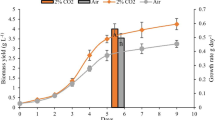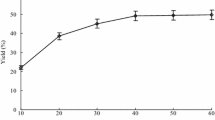Abstract
Sulphated polysaccharides (SP) were extracted from Fucus vesiculosus seaweed by using two different hydrothermal processes: microwave-assisted extraction (MAE) and autohydrolysis (AH). The extraction yields, chemical composition, and antioxidant activity of the polysaccharides extracted were determined and compared. Although both processes afforded SP with similar yields (18.2 mass % and 16.5 mass %, for MAE and AH, respectively) and l-fucose as the main monosaccharide, the heterogeneous structure of the polysaccharide recovered was significantly affected by the AH process. The SP obtained by MAE contained 53.8 mole % of fucose, 35.3 mole % of xylose, and 10.8 mole % of galactose; while the SP obtained by AH was composed of 76.8 mole % of fucose and 23.2 mole % of galactose. Both samples presented comparable values of antioxidant activity by the di(phenyl)-(2,4,6-trinitrophenyl)iminoazanium (2,2-diphenyl-1-picrylhydrazyl, DPPH), 2,2′-azino-bis(3-ethylbenzthiazoline-6-sulphonic acid) (ABTS), and lipid oxidation inhibition methods, but the polysaccharide obtained by AH exhibited a higher antioxidant potential by the differential pulse voltammetry technique. This study demonstrates that the chemical composition and antioxidant activity of SP obtained from F. vesiculosus vary according to the process used for their extraction. However, the SP obtained by MAE or AH both have the potential for use as natural antioxidants in industrial applications.
Similar content being viewed by others
References
Barahona, T., Chandía, N. P., Encinas, M. V., Matsuhiro, B., & Zúñiga, E. A. (2011). Antioxidant capacity of sulfated polysaccharides from seaweeds. A kinetic approach. Food Hydrocolloids, 25, 529–535. DOI: 10.1016/j.foodhyd.2010.08.004.
Barros, L., Falcão, S., Baptista, P., Freire, C., Vilas-Boas, M., & Ferreira, I. C. F. R. (2008). Antioxidant activity of Agaricus sp. mushrooms by chemical, biochemical and electrochemical assays. Food Chemistry, 111, 61–66. DOI:10.1016/j.foodchem.2008.03.033.
Bhakuni, D. S., & Rawat, D. S. (2005). Bioactive marine natural products. New York, NY, USA: Springer.
Costa, L. S., Fidelis, G. P., Cordeiro, S. L., Oliveira, R. M., Sabry, D. A., Câmara, R. B. G., Nobre, L. T. D. B., Costa, M. S. S. P., Almeida-Lima, J., Farias, E. H. C., Leite, E. L., & Rocha, H. A. O. (2010). Biological activities of sulfated polysaccharides from tropical seaweeds. Biomedicine & Pharmacotherapy, 64, 21–28. DOI: 10.1016/j.biopha.2009.03.005.
Dodgson, K. S. (1961). Determination of inorganic sulphate in studies on the enzymic and non-enzymic hydrolysis of carbohydrate and other sulphate esters. Biochemical Journal, 78, 312–319.
Garrote, G., Domínguez, H., & Parajó, J. C. (1999). Hydrothermal processing of lignocellulosic materials. Holz als Roh- und Werksttoff, 57, 191–202. DOI: 10.1007/s001070050039.
Halliwell, B. (2012). Free radicals and antioxidants: updating a personal view. Nutrition Reviews, 70, 257–265. DOI: 10.1111/j.1753-4887.2012.00476.x.
Haroun-Bouhedja, F., Ellouali, M., Sinquin, C., & Boisson-Vidal, C. (2000). Relationship between sulfate groups and biological activities of fucans. Thrombosis Research, 100, 453–459. DOI: 10.1016/s0049-3848(00)00338-8.
Hu, F. L., Lu, R. L., Huang, B., & Ming, L. (2004). Free radical scavenging activity of extracts prepared from fresh leaves of selected Chinese medicinal plants. Fitoterapia, 75, 14–23. DOI: 10.1016/j.fitote.2003.07.003.
Jiao, G. L., Yu, G. L., Wang, W., Zhao, X. L., Zhang, J. Z., & Ewart, S. H. (2012). Properties of polysaccharides in several seaweeds from Atlantic Canada and their potential anti-influenza viral activities. Journal of Ocean University of China, 11, 205–212. DOI: 10.1007/s11802-012-1906-x.
Kim, D. O., & Lee, C. Y. (2002). Extraction and isolation of polyphenolics. Current Protocols in Food Analytical Chemistry, 6, I1.2.1–I1.2.12. DOI: 10.1002/0471142913.fai0102s06.
Korotkova, E. I., Karbainov, Y. A., & Shevchuk, A. V. (2002). Study of antioxidant properties by voltammetry. Journal of Electroanalytical Chemistry, 518, 56–60. DOI: 10.1016/s0022-0728(01)00664-7.
Li, B., Lu, F., Wei, X. J., & Zhao, R. X. (2008). Fucoidan: Structure and bioactivity. Molecules, 13, 1671–1695. DOI:10.3390/molecules13081671.
Lim, S. N., Cheung, P. C. K., Ooi, V. E. C., & Ang, P. O. (2002). Evaluation of antioxidative activity of extracts from a brown seaweed, Sargassum siliquastrum. Journal of Agricultural and Food Chemistry, 50, 3862–3866. DOI: 10.1021/jf020096b.
Mao, W. J., Zang, X. X., Li, Y., & Zhang, H. J. (2006). Sulfated polysaccharides from marine green algae Ulva conglobata and their anticoagulant activity. Journal of Applied Phycology, 18, 9–14. DOI: 10.1007/s10811-005-9008-4.
Martins, S., Aguilar, C. N., Teixeira, J. A., & Mussatto, S. I. (2012). Bioactive compounds (phytoestrogens) recovery from Larrea tridentata leaves by solvents extraction. Separation and Purification Technology, 88, 163–167. DOI: 10.1016/j.seppur.2011.12.020.
Qi, H. M., Zhao, T. T., Zhang, Q. B., Li, Z., Zhao, Z. Q., & Xing, R. (2005). Antioxidant activity of different molecular weight sulfated polysaccharides from Ulva pertusa Kjellm (Chlorophyta). Journal of Applied Phycology, 17, 527–534. DOI: 10.1007/s10811-005-9003-9.
Rioux, L. E., Turgeon, S. L., & Beaulieu, M. (2007). Characterization of polysaccharides extracted from brown seaweeds. Carbohydrate Polymers, 69, 530–537. DOI: 10.1016/j. carbpol.2007.01.009.
Rodriguez-Jasso, R. M., Mussatto, S. I., Pastrana, L., Aguilar, C. N., & Teixeira, J. A. (2011). Microwave-assisted extraction of sulfated polysaccharides (fucoidan) from brown seaweed. Carbohydrate Polymers, 86, 1137–1144. DOI: 10.1016/j.carbpol.2011.06.006.
Rodriguez-Jasso, R. M., Mussatto, S. I., Pastrana, L., Aguilar, C. N., & Teixeira, J. A. (2013). Extraction of sulfated polysaccharides by autohydrolysis of brown seaweed Fucus vesiculosus. Journal of Applied Phycology, 25, 31–39. DOI: 10.1007/s10811-012-9834-0.
Rupérez, P., Ahrazem, O., & Leal, J. A. (2002). Potential antioxidant capacity of sulfated polysaccharides from the edible marine brown seaweed Fucus vesiculosus. Journal of Agricultural and Food Chemistry, 50, 840–845. DOI: 10.1021/jf010908o.
Schaeffer, D. J., & Krylov, V. S. (2000). Anti-HIV activity of extracts and compounds from algae and cyanobacteria. Ecotoxicology and Environmental Safety, 45, 208–227. DOI: 10.1006/eesa.1999.1862.
Sokolova, E. V., Barabanova, A. O., Bogdanovich, R. N., Khomenko, V. A., Solov’eva, T. F., & Yermak, I. M. (2011). In vitro antioxidant properties of red algal polysaccharides. Biomedicine & Preventive Nutrition, 1, 161–167. DOI: 10.1016/j.bionut.2011.06.011.
Wang, J., Zhang, Q. B., Zhang, Z. S., Song, H. F., & Li, P. C. (2010). Potential antioxidant and anticoagulant capacity of low molecular weight fucoidan fractions extracted from Laminaria japonica. International Journal of Biological Macromolecules, 46, 6–12. DOI: 10.1016/j.ijbiomac.2009.10.015.
Wijesekara, I., Pangestuti, R., & Kim, S. K. (2011). Biological activities and potential health benefits of sulfated polysaccharides derived from marine algae. Carbohydrate Polymers, 84, 14–21. DOI: 10.1016/j.carbpol.2010.10.062.
Wijesinghe, W. A. J. P., & Jeon, Y. J. (2012). Biological activities and potential industrial applications of fucose rich sulfated polysaccharides and fucoidans isolated from brown seaweeds: A review. Carbohydrate Polymers, 88, 13–20. DOI: 10.1016/j.carbpol.2011.12.029.
Yuan, H. M., Zhang, W. W., Li, X. G., Lü, X. X., Li, N., Gao, X. L., & Song, J. M. (2005). Preparation and in vitro antioxidant activity of κ-carrageenan oligosaccharides and their oversulfated, acetylated, and phosphorylated derivatives. Carbohydrate Research, 340, 685–692. DOI: 10.1016/j.carres.2004.12.026.
Author information
Authors and Affiliations
Corresponding author
Rights and permissions
About this article
Cite this article
Rodriguez-Jasso, R.M., Mussatto, S.I., Pastrana, L. et al. Chemical composition and antioxidant activity of sulphated polysaccharides extracted from Fucus vesiculosus using different hydrothermal processes. Chem. Pap. 68, 203–209 (2014). https://doi.org/10.2478/s11696-013-0430-9
Received:
Revised:
Accepted:
Published:
Issue Date:
DOI: https://doi.org/10.2478/s11696-013-0430-9




